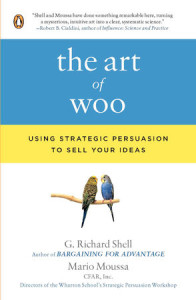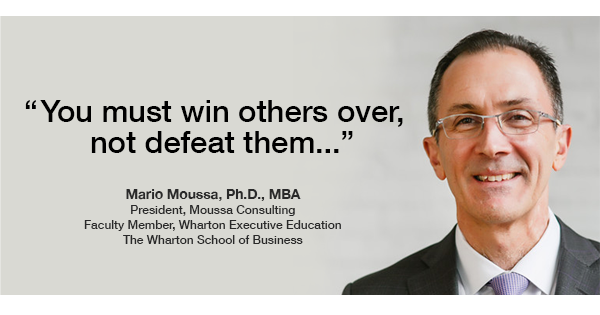
Dr. Relly Nadler: This week’s episode is The Art of Woo: Using Strategic Persuasion to Sell Ideas. No, is a word few of us like to hear especially when presenting an idea we feel very enthusiastic about. How do people like Andy Grove and Bono know how to persuade others so effectively. What can we learn about effective persuasion and why what you say may not be as important as how you say it. What makes someone a good persuader? Do executives really need to woo anyone? Can they just use their authority and influence to make things happen? How often have you seen business people use numbers and facts to get people on board? Are they really effective or not? These are questions that are going to be the focus of the show.
Dr. Cathy Greenberg: Mario Moussa is a PhD and MBA. He’s a principle and a member of the management committee at CFAR, a Strategy and Leadership Consulting firm that spun of from the Wharton School of Business in 1987. CFAR stands for the Center For Applied Research. Dr. Moussa teaches in the Wharton Executive Programs and is a senior fellow at the University of Pennsylvania’s Leonard Davis Institute of Economics. In his book The Art of Woo, using Strategic Persuasion to Sell Your Ideas, Mario explains why wooing is one of the most important skills for any entrepreneur, employee, or professional manager whose work requires them to rely on influence and persuasion rather than coercion and force.
Mario advises senior corporate executives about strategy and competitiveness. His clients include many of the top companies and organizations in the country. He’s a specialist in large-scale organizational change initiatives and he has led projects at United Health Group, PNC Bank, The Georgetown University Medical Center and State Farm Insurance.
At Wharton, Dr. Moussa directs numerous programs for corporate leaders and since 1998 he has been the Academic Director of Essentials of Management, one of the schools flagship executive programs.
He has also led the development of programs for banking executives, corporate security managers, energy executives, and physician leaders. He teaches negotiation and influence, strategy, change and corporate culture. He regularly delivers keynote presentations and workshop for clients around the world.
Dr. Moussa is the co-author with G. Richard Shell of The Art of Woo: Using Strategic Persuasion to Sell Uour Ideas. He has published widely in the field of organizational dynamics, power and influence. His work has been featured on national public radio and in print publications around the world, including Time Magazine, Business Week, US News and World Report, The Harvard Management Update, and the Toronto Globe and Mail.
His writings have been used in university and graduate seminars across the world. Dr. Moussa graduated from the Wharton MBA program and holds a PhD from the University of Chicago’s committed on Social Thought, where he was a graduate Fellow. He lives in Center City, Philadelphia with his wife and three children.
I was fortunate enough to meet Mario a few years ago when was leading a leadership development effort for a major mid-Atlantic regional bank where we met, we were teamed together by the client to bring added value to their strategic planning efforts, now being implemented. Mario, welcome to the show.
Dr. Moussa: Thank you Cathy.
Dr. Cathy Greenberg: Relly and I would like to start off by talking about your book, I hope you don’t mind. We are very excited about The Art of Woo, something that many of us are obviously interested in. Relly, can you kick us off with a few questions to Mario?
Dr. Relly Nadler: Sure. Mario, for the first question we have, and this is all about selling, how is selling an idea different than selling a product, or is it different?
Dr. Moussa: Sure. Great question Relly. If differs in three ways. The first point is that it is relationship based. So it’s about you connecting with another person. So the selling happens within the relationship and another key factor related to that is that it has to do with credibility. Your credibility, your being perceived as credible. What we fin is if you don’t have credibility, your sale is going to go nowhere. It doesn’t really matter if the idea is the best idea in the world, it doesn’t matter what you are saying, you could say 2 + 2 = 4, but if you are not seen as credible, the sale is going to flounder.
So this is the first difference when it comes to selling ideas. Then second, at work and even in relatively small organizations, an ideal sale may need to be made to as many as 20 people. There’s actually quite a bit of research about that. Even the most simple ideas need to be touched in one way or another by at least 5 people. So not only is idea sales relationship based, but you have to sell an idea again, and again, and again, so that means you need some stamina when it comes to selling your idea.
Lastly, and third, your sale needs to be tailored to every person. So this is not about mass markets selling. We like to say that when it comes to changing an organization you need to do it one person at a time. That means you need to focus on how that person hears you, you need to adapt your style to them. It’s very specific, one person at a time, and you can think of it as relationship rich.
So very much connected to the themes that you and Cathy were talking about earlier. It’s a high EQ activity.
Dr. Cathy Greenberg: Mario, I have a question for you. Where did you come up with the idea for this kind of a book? You have been talking to us about selling an idea, how did you get the idea for the book and how did you sell that idea. Because it seems to me like people would say, wow, we are all good sales people. Why do we need this?
Dr. Moussa: Yes, that’s interesting. Well, it goes back to the work that Richard and I, by co-author Richard Shell and I, had been doing for years at Wharton. Specifically, his executive negotiation workshop. That is one of the places where all of this started. What he heard again and again from the executives that he works with and then I as well began to hear this, is that some of their most difficult negotiations are the internal ones.
Our expectation was that executives would want to focus on selling to vendors and other outside parties but, they had a lot of war stories, bloody war stories about how hard it is to get their ideas sold internally.
So we started to think about that and use some of our negotiation tools to help them. What we found is that those internal sales required a different kind of skillset related to the negotiation skillset, but also importantly different.
We started working with executives on influence and persuasion and what we came to call selling ideas. I can come back to what is behind that idea again, but started working on the tools, refining them, and what we found is that there’s an important difference which we touched on just a little bit earlier in our conversation, it’s very relationship based.
While when you are negotiating with an outside vendor, let’s say, and there are certain situations where you can think transactionally about it, it’s a one time deal, you don’t have to think about the long-term relationship. At work, inside an organization, it’s very rare that you don’t have to have that long time horizon, and that really changes everything.
You can listen to the entire interview, above.
Relly

